新概念英语时态讲解及练习题(五种时态)
- 格式:doc
- 大小:30.00 KB
- 文档页数:8


新概念第一册八大时态总结一.一般现在时1.结构基本结构否定句一般疑问句be动词am/is/are+not be提前,放于句首实义动词don’t/doesn’t+do(动词原形)Do/Does+主语+do(动词原形)…?2.用法1)表示经常的、习惯性的动作或存在的状态,常与表示频度的副词连用。
常用的频度副词有:always、often、usually、seldom、never、sometimes, every week (day, year, month…), once a week, on Sundays.频度副词在句中通常放在行为动词之前,系动词、助动词之后。
2)表示主语具备的性格、特征和能力等。
All my friends love football .3)表示客观真理、客观存在、自然现象。
The earth moves around the sun.4)if 引导的条件状语从句主将从现I'll tell him the news if he comes back.二.一般过去时态1.结构基本结构否定句一般疑问句be动词was/were+not was/were提前,放于句首实义动词didn’t+do(动词原形)Did+主语+do(动词原形)…?2.用法表示过去某一时刻或某一段时间里所发生的动作或情况。
常和表示过去的时间状语yesterday, just now, the other day(几天前), in 1982, ago, an hour ago, long long ago, the day before yesterday, last week(year, night, month…), at the age of 5, one day, once upon a time等连用三.一般将来时1.结构一、句型结构:1.be going to 主语+(am/is/are)going to +动词原形2.will :主语+will+动词原形(will为助动词,与情态动词用法相同,与动词原形构成谓语,不需要根据人称进行变化。
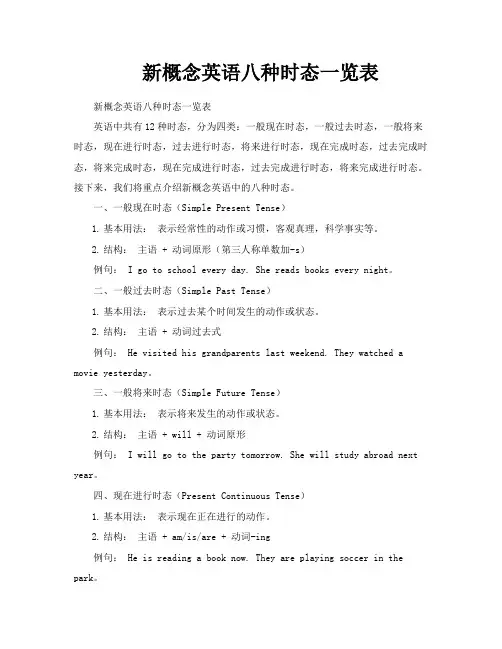
新概念英语八种时态一览表新概念英语八种时态一览表英语中共有12种时态,分为四类:一般现在时态,一般过去时态,一般将来时态,现在进行时态,过去进行时态,将来进行时态,现在完成时态,过去完成时态,将来完成时态,现在完成进行时态,过去完成进行时态,将来完成进行时态。
接下来,我们将重点介绍新概念英语中的八种时态。
一、一般现在时态(Simple Present Tense)1.基本用法:表示经常性的动作或习惯,客观真理,科学事实等。
2.结构:主语 + 动词原形(第三人称单数加-s)例句: I go to school every day. She reads books every night。
二、一般过去时态(Simple Past Tense)1.基本用法:表示过去某个时间发生的动作或状态。
2.结构:主语 + 动词过去式例句: He visited his grandparents last weekend. They watched a movie yesterday。
三、一般将来时态(Simple Future Tense)1.基本用法:表示将来发生的动作或状态。
2.结构:主语 + will + 动词原形例句: I will go to the party tomorrow. She will study abroad next year。
四、现在进行时态(Present Continuous Tense)1.基本用法:表示现在正在进行的动作。
2.结构:主语 + am/is/are + 动词-ing例句: He is reading a book now. They are playing soccer in the park。
五、过去进行时态(Past Continuous Tense)1.基本用法:表示过去某个时间正在进行的动作。
2.结构:主语 + was/were + 动词-ing例句: She was studying when I called her. They were watching TV at that time。
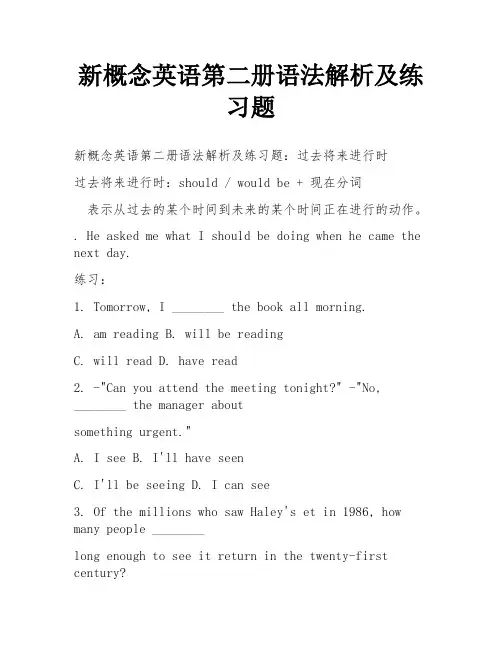
新概念英语第二册语法解析及练习题新概念英语第二册语法解析及练习题:过去将来进行时过去将来进行时:should / would be + 现在分词表示从过去的某个时间到未来的某个时间正在进行的动作。
. He asked me what I should be doing when he came the next day.练习:1. Tomorrow, I ________ the book all morning.A. am readingB. will be readingC. will readD. have read2. -"Can you attend the meeting tonight?" -"No,________ the manager aboutsomething urgent."A. I seeB. I'll have seenC. I'll be seeingD. I can see3. Of the millions who saw Haley's et in 1986, how many people ________long enough to see it return in the twenty-first century?A. will they liveB. they will be livingC. will liveD. living4. He told us that he ________ visiting Japan by this time next year.A. will beB. would beC. wasD. is5. It ________ when you wake up tomorrow morning.A. is snowingB. will snowC. will be snowingD. snows答案:1. B2. C3. C4. B5. C新概念英语第二册语法解析及练习题:过去完成进行时过去完成进行时:had been + 现在分词表示一直持续到过去某个时间的动作。

新概念前100课时态语法总结一般现在时A:一般现在时结构:1)be动词的第一人称单数为,第三人称单数为,其他人称为。
有一顺口溜体现了它的用法:我用am ,你用are ,is 用于他,她,它, 单数is,复数are.肯定式:主语+ am /is/are +其他否定式:主语+ am/is/are +not + 其他疑问式:Am /Is /Are + 主语+ 其他?简略回答: (肯) Yes,主语+ am/ is /are(否) No,主语+ am /is/are not缩写形式: I'm that's we'rewhat's they're isn'tyou're who's where's he'sshe's it's aren't2)行为动词(实义动词)除主语是第三人称单数外,都用动词原形,主语是第三人称单数时,在动词词尾加-s或-es 。
肯定式:主语+动词原形/动词的第三人称单数否定式:主语+助动词don't/doesn't +动词原形+其他疑问式:Do/Does+主语+动词原形+其他简略回答:(肯)Yes,主语+do/does (否)No,主语+do/does not缩写形式: don't doesn't注意:“动词第三人称单数”的加法即“如何从动词原形变为第三人称单数”1、一般情况加s.2、以o, s, x, ch, sh 结尾加es.3、以“辅音字母+y”结尾,改y为i +es练习一写出下列动词的第三人称单数:study play go comehelp teach lie listenbegin open sit washguess eat run relaxB一般现在时用法经常性或习惯性的动作,常与表示频度的时间状语连用。
时间状语:always, usually, often, frequently, sometimes, hardly, never, every day (week, year, month/), once a week, on Sundays, etc.现在进行时现在进行时表示目前或目前阶段正在进行的动作。
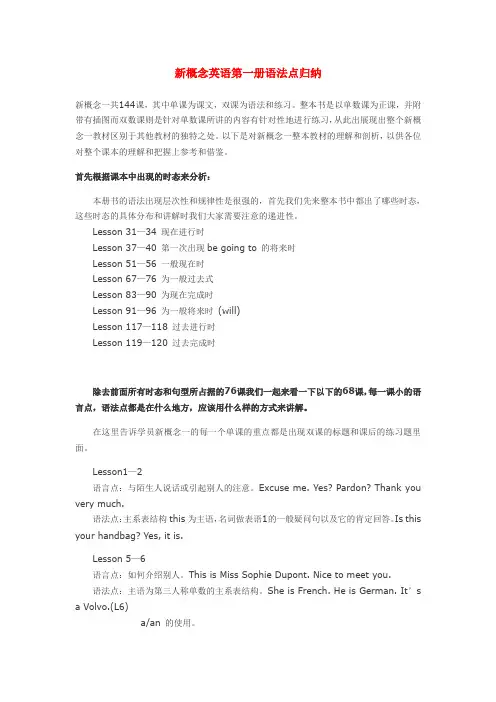
新概念英语第一册语法点归纳新概念一共144课,其中单课为课文,双课为语法和练习。
整本书是以单数课为正课,并附带有插图而双数课则是针对单数课所讲的内容有针对性地进行练习,从此出展现出整个新概念一教材区别于其他教材的独特之处。
以下是对新概念一整本教材的理解和剖析,以供各位对整个课本的理解和把握上参考和借鉴。
首先根据课本中出现的时态来分析:本册书的语法出现层次性和规律性是很强的,首先我们先来整本书中都出了哪些时态,这些时态的具体分布和讲解时我们大家需要注意的递进性。
Lesson 31—34 现在进行时Lesson 37—40 第一次出现be going to 的将来时Lesson 51—56 一般现在时Lesson 67—76 为一般过去式Lesson 83—90 为现在完成时Lesson 91—96 为一般将来时(will)Lesson 117—118 过去进行时Lesson 119—120 过去完成时除去前面所有时态和句型所占据的76课我们一起来看一下以下的68课,每一课小的语言点,语法点都是在什么地方,应该用什么样的方式来讲解。
在这里告诉学员新概念一的每一个单课的重点都是出现双课的标题和课后的练习题里面。
Lesson1—2语言点:与陌生人说话或引起别人的注意。
Excuse me. Yes? Pardon? Thank you very much.语法点:主系表结构this为主语,名词做表语1的一般疑问句以及它的肯定回答。
Is this your handbag? Yes, it is.Lesson 5—6语言点:如何介绍别人。
This is Miss Sophie Dupont. Nice to meet you.语法点:主语为第三人称单数的主系表结构。
She is French. He is German. It’s a Volvo.(L6)a/an 的使用。
Lesson 7—8语言点:如何自我介绍和相互认识。
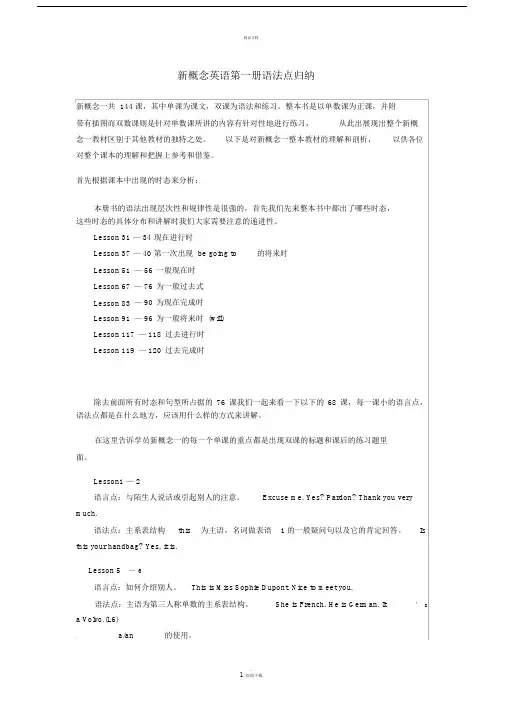
精品文档新概念英语第一册语法点归纳新概念一共 144课,其中单课为课文,双课为语法和练习。
整本书是以单数课为正课,并附带有插图而双数课则是针对单数课所讲的内容有针对性地进行练习,从此出展现出整个新概念一教材区别于其他教材的独特之处。
以下是对新概念一整本教材的理解和剖析,以供各位对整个课本的理解和把握上参考和借鉴。
首先根据课本中出现的时态来分析:本册书的语法出现层次性和规律性是很强的,首先我们先来整本书中都出了哪些时态,这些时态的具体分布和讲解时我们大家需要注意的递进性。
Lesson 31 — 34 现在进行时Lesson 37 — 40 第一次出现 be going to的将来时Lesson 51— 56一般现在时Lesson 67— 76为一般过去式Lesson 83— 90为现在完成时Lesson 91— 96为一般将来时 (will)Lesson 117— 118过去进行时Lesson 119— 120过去完成时除去前面所有时态和句型所占据的76课我们一起来看一下以下的68课,每一课小的语言点,语法点都是在什么地方,应该用什么样的方式来讲解。
在这里告诉学员新概念一的每一个单课的重点都是出现双课的标题和课后的练习题里面。
Lesson1 — 2语言点:与陌生人说话或引起别人的注意。
Excuse me. Yes? Pardon? Thank you very much.语法点:主系表结构this为主语,名词做表语1的一般疑问句以及它的肯定回答。
Is this your handbag? Yes, it is.Lesson 5—6语言点:如何介绍别人。
This is Miss Sophie Dupont. Nice to meet you.语法点:主语为第三人称单数的主系表结构。
She is French. He is German. It’ s a Volvo.(L6)a/an的使用。
Lesson 7 — 8言点:如何自我介和相互。
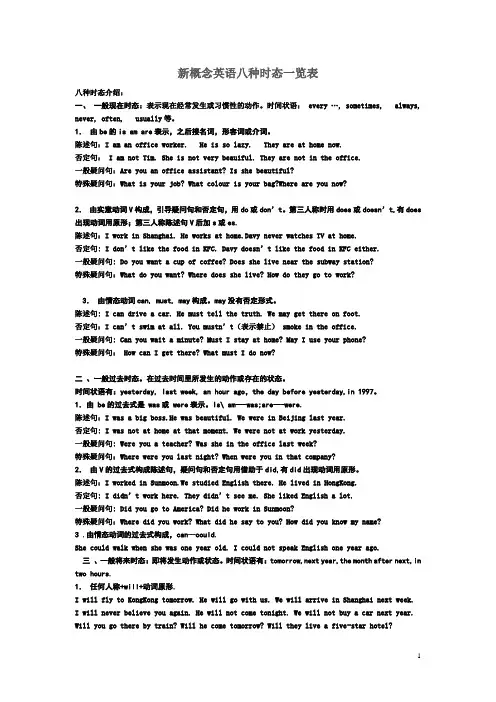
新概念英语八种时态一览表八种时态介绍:一、一般现在时态:表示现在经常发生或习惯性的动作。
时间状语:every …, sometimes, always, never, often, usually等。
1.由be的is am are表示,之后接名词,形容词或介词。
陈述句:I am an office worker. He is so lazy. They are at home now.否定句: I am not Tim. She is not very beauiful. They are not in the office.一般疑问句:Are you an office assistant? Is she beautiful?特殊疑问句:What is your job? What colour is your bag?Where are you now?2.由实意动词V构成,引导疑问句和否定句,用do或don’t。
第三人称时用does或doesn’t,有does 出现动词用原形;第三人称陈述句V后加s或es.陈述句:I work in Shanghai. He works at home.Davy never watches TV at home.否定句: I don’t like the food in KFC. Davy doesn’t like the food in KFC either.一般疑问句: Do you want a cup of coffee? Does she live near the subway station?特殊疑问句:What do you want? Where does she live? How do they go to work?3.由情态动词can, must, may构成。
may没有否定形式。
陈述句: I can drive a car. He must tell the truth. We may get there on foot.否定句:I can’t swim at all. You mustn’t(表示禁止) smoke in the office.一般疑问句: Can you wait a minute? Must I stay at home? May I use your phone?特殊疑问句: How can I get there? What must I do now?二、一般过去时态。
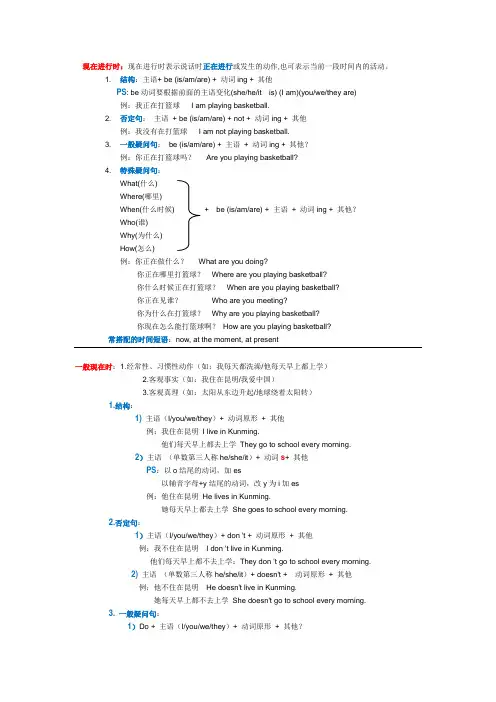
现在进行时:现在进行时表示说话时正在进行或发生的动作,也可表示当前一段时间内的活动。
1. 结构:主语+ be (is/am/are) + 动词ing + 其他PS: be动词要根据前面的主语变化(she/he/it is) (I am)(you/we/they are)例:我正在打篮球I am playing basketball.2. 否定句:主语+ be (is/am/are) + not + 动词ing + 其他例:我没有在打篮球I am not playing basketball.3. 一般疑问句:be (is/am/are) + 主语+ 动词ing + 其他?例:你正在打篮球吗?Are you playing basketball?4. 特殊疑问句:What(什么)Where(哪里)When(什么时候) + be (is/am/are) + 主语+ 动词ing + 其他?Who(谁)Why(为什么)How(怎么)例:你正在做什么?What are you doing?你正在哪里打篮球?Where are you playing basketball?你什么时候正在打篮球?When are you playing basketball?你正在见谁?Who are you meeting?你为什么在打篮球?Why are you playing basketball?你现在怎么能打篮球啊?How are you playing basketball?常搭配的时间短语:now, at the moment, at present一般现在时:1.经常性、习惯性动作(如:我每天都洗澡/他每天早上都上学)2.客观事实(如:我住在昆明/我爱中国)3.客观真理(如:太阳从东边升起/地球绕着太阳转)1.结构:1)主语(I/you/we/they)+ 动词原形+ 其他例:我住在昆明I live in Kunming.他们每天早上都去上学They go to school every morning.2)主语(单数第三人称he/she/it)+ 动词s+ 其他PS:以o结尾的动词,加es以辅音字母+y结尾的动词,改y为i加es例:他住在昆明He lives in Kunming.她每天早上都去上学She goes to school every morning.2.否定句:1)主语(I/you/we/they)+ don 't + 动词原形+ 其他例:我不住在昆明I don 't live in Kunming.他们每天早上都不去上学:They don 't go to school every morning.2)主语(单数第三人称he/she/it)+ doesn't + 动词原形+ 其他例:他不住在昆明He doesn't live in Kunming.她每天早上都不去上学She doesn't go to school every morning.3.一般疑问句:1)Do + 主语(I/you/we/they)+ 动词原形+ 其他?回答:Yes, 主语(I/you/we/they)+ do.No, 主语(I/you/we/they)+ don 't.例:你住在昆明吗?Do you live in Kunming?Yes, I do. / No, I don 't.他们每天都去上学吗?Do they go to school every day?Yes, they do. / No, they don 't.2)does + 主语(单数第三人称he/she/it)+ 动词原形+ 其他?回答:Yes, 主语(单数第三人称he/she/it)+ does.No, 主语(单数第三人称he/she/it)+ doesn't.例:他住在昆明吗?Does he live in Kunming?Yes, he does. / No, he doesn't.她每天都去上学吗?Does she go to school every day?Yes, she does. / No, she doesn't4.特殊疑问句:1)What(什么)Where(哪里)When(什么时候) + do + 主语(I/you/we/they)+ 动词原形+ 其他?Who(谁)Why(为什么)How(怎么)例:你每天早上做什么?What do you do every morning?你每天早上去哪里?Where do you go every morning?你每天什么时候去上学?When do you go to school every day?你每天都见谁?Who do you meet every day?你为什么喜欢中国?Why do you like China?你每天都怎么去上学?How do you go to school every day?2)What(什么)Where(哪里)When(什么时候) + does + 主语(单数第三人称he/she/it)+ 动词原形+ 其他?Who(谁)Why(为什么)How(怎么)例:他每天早上做什么?What does he do every morning?他每天早上去哪里?Where does he go every morning?他每天什么时候去上学?When does he go to school every day?他每天都见谁?Who does he meet every day?他为什么喜欢中国?Why does he like China?他每天都怎么去上学?How does he go to school every day?常搭配的时间:sometimes有时,often经常,usually通常,always总是,在早上:in the morning 每天早上:every morning在下午:in the afternoon 每天下午:every afternoon在傍晚:in the evening 每天傍晚:every evening在晚上:at night 每天晚上:every night每天/周/月/年:every day/week/month/year一般过去时:表示过去某个时间发生而现在已经结束的动作或存在的状态。

五种时态讲解及练习题英语的时态(tense)是一种动词形式,不同的时态用以表示不同的时间与方式。
下面就英语中常见的八种基本时态进行阐述,其它的时态都是在这八种时态的基础上结合而成的。
一、一般现在时:1.概念:经常、反复发生的动作或行为及现在的某种状况。
2.时间状语:always, usually, often, sometimes, every week (day, year, month...), once a week, on Sundays,3.基本结构:动词原形(如主语为第三人称单数,动词上要加(e)S)4.否定形式:am/is/are+not;此时态的谓语动词若为行为动词,则在其前加don't,如主语为第三人称单数,则用doesn't,通常还原行为动词。
5.一般疑问句:把be动词放于句首;用助动词do提问,如主语为第三人称单数,则用does,同时,还原行为动词。
6.例句:It seldom snows here.He is always ready to help others.Action speaks louder than words.1.I like ____________ (swim). 2.He _________(read) English every day. 3.We _________(go)to school at seven in the morning. 4.Mike________(go)to school at seven in the morning. 5.My mother________(like) ______(go) shopping. 6.I can ________(draw) many beautiful pictures. 7.She_________(make) a model plane. 8.Do you ________(like)_________(run)? 9.Does he_________(like)_________(jump) ? 10.Does Nancy_________(grow)flowers on Saturday ? 11.The teachers________(like)___________(dance). 12.The teacher________(like)____________(dance).2)用所给的人称改写句子 1.I take photos on Sunday. ( Mike) 2.We grow beautiful flowers. (she) 3.They like collecting stamps. (Ben) 4.I listen to music carefully. (my aunt) 5.You like making a model ship. (Helen二、一般过去时:1.概念:过去某个时间里发生的动作或状态;过去习惯性、经常性的动作、行为。

新概念英语语法:All Tenses 时态(共16种):一般时: 现在 The Present Indefinite/. 过去 The Simple Past Tense . 将来 The Simple Future Tense过去将来现在 进行时 The Present Continuous Tense过去 Past Continuous Tense将来 The Future Continuous Tense过去将来现在 完成时 The Present Perfect Tense 过去 The Past Perfect Tense将来 The Future Perfect Tense 过去将来过去 完成进行时 现在 将来 过 去 >> 现 在 >> 将 来 >>过去将来 >>动词时态的构成 (主动形式)时态的构成例句( 分别以I, He 为主语和sit, do 为谓语动词为例)现 在 过 去 将 来 过 去 将 来 一般 I sitHe does.I sat He did I shall sit He will do I should sit He would do完成 I have sat He has done I had sat He had done I shall have sat He will have done I should have sat He would have done 进行 I am sitting He is doingI was sitting He was doingI shall be sitting He will be doingI Should be sitting He would be doing完成进行I have been sitting He has been doing I Had been sitting He had been doingI shall have been sitting He will have been doingI should have been sitting He would have been doing动词时态的被动形式(Passive Voice )的构成: (共10种时态有被动形式)现在过去将来过去将来一般时 I sitI satI shall sitI should sit进行时 I am sitting I was sitting I shall be sitting I should be sitting. 完成时 I have satI had satI shall have satI should have sat完成进行时I have been sittingI had been sittingI shall have been sittingI should have been sitting现在过去将来过去将来一般时am (is; are )given was/were given shall/will be given should/would be given 进行时am( are; is ) being given Was/were being give n / /完成时Have(has) been given Had been given Shall/will have been given Would have been given时态构成常连用的时间状语用法及例句一般现在时do /does(动词原形, 第三人称单数词尾加-s)every …,sometimes,at …,on Sundayalways,often,usually,1.表示经常性或习惯性的动作。
新概念英语时态讲解及练习题(五种时态)五种时态讲解及练习题英语的时态(tense)是一种动词形式,不同的时态用以表示不同的时间与方式。
下面就英语中常见的八种基本时态进行阐述,其它的时态都是在这八种时态的基础上结合而成的。
一、一般现在时:1.概念:经常、反复发生的动作或行为及现在的某种状况。
2.时间状语:always, usually, often, sometimes, every week (day, year, month...), on ce a week, on Sundays,3.基本结构:动词原形(如主语为第三人称单数,动词上要加(e)S)4.否定形式:am/is/are+not;此时态的谓语动词若为行为动词,则在其前加don't,如主语为第三人称单数,则用doesn't,通常还原行为动词。
5.一般疑问句:把be动词放于句首;用助动词do提问,如主语为第三人称单数,则用does,同时,还原行为动词。
6.例句:It seldom snows here.He is always ready to help others.Action speaks louder than words.1.I like ____________ (swim).2.He _________(read) English every day.3.We _________(go)to school at seven in the morning.4.Mike________(go)to school at seven in the morning.5.My mother________(like) ______(go) shopping.6.I can ________(draw) many beautiful pictures.7.She_________(make) a model plane.8.Do you ________(like)_________(run)?9.Does he_________(like)_________(jump) ?10.Does Nancy_________(grow)flowers on Saturday ?11.The teachers________(like)___________(dance).12.The teacher________(like)____________(dance).2)用所给的人称改写句子1.I take photos on Sunday. ( Mike)2.We grow beautiful flowers. (she)3.They like collecting stamps. (Ben)4.I listen to music carefully. (my aunt)5.You like making a model ship. (Helen二、一般过去时:1.概念:过去某个时间里发生的动作或状态;过去习惯性、经常性的动作、行为。
新概念英语第二册语法解析及练习题分享新概念英语作为家喻户晓的经典之作,它有着全新的教学理念,有趣的课文内容及其全面的技能训练,今天小编给大家带来新概念英语第二册语法解析及练习题,希望可以帮助到大家,下面小编就和大家分享,来欣赏一下吧。
新概念英语第二册语法解析及练习题:现在完成进行时一.现在完成进行时:have / has + been + 现在分词1.表示从过去某时开始发生,一直延续到现在且可能延续下去的动作。
(将此定义读 5遍)I've been waiting for an hour but she hasn't come.He has been running after her for 8 years.(run after: 追求)2.表某种感情色彩。
I've been wanting to see you for so many years.Who's been telling you such nonsense.释惑要点:现在完成时与现在完成进行时的对比:现在完成时强调“结果”,而完成进行时强调“动作的延续”。
I have thought of it.(我已想到了这一点。
)I have been thinking of it.(我一直在想这一点。
)Jim has painted the door.(杰姆已将门油漆过了。
)Jim has been painting the door.(杰姆一直在油漆门。
)练习:1. They ________ us since five o'clock this morning.A. are helpingB. have been helpingC. have been helpedD. have helped2. I ________ the book the whole day, yet I haven't finished it.A. have been readingB. have readC. am readingD. had been reading3. Please come in. We ________ about your paper.A. talkB. had been talkingC. have been talkingD. would have talked4. Such natural resources as coal and petroleum ________.A. gradually are exhaustedB. are being gradually exhaustedC. have gradually exhaustingD. have been exhausting gradually5. It ________ almost every day so far this month.A. is rainingB. rainedC. rainsD. has been raining用所给动词正确时态填空。
五种重点时态语法及练习1一般现一般现在时一般现在时一般现在时基本用法介绍一般现在时的功能1.表示事物或人物的特征、状态。
如:The sky is blue.天空是蓝色的。
2.表示经常性或习惯性的动作。
如:I get up at six every day.我每天六点起床。
3.表示客观现实。
如:The earth goes around the sun.地球绕着太阳转。
一般现在时的构成1. be动词:主语+be(am,is,are)+其它。
如:I am a boy.我是一个男孩。
2.行为动词:主语+行为动词(+其它)。
如:We study English.我们学习英语。
当主语为第三人称单数(he, she,it)时,要在动词后加"-s"或"-es"。
如:Mary likes Chinese.玛丽喜欢汉语。
一般现在时的变化1. be动词的变化。
否定句:主语+ be + not +其它。
如:He is not a worker.他不是工人。
一般疑问句:Be +主语+其它。
如:-Are you a student? -Yes. I am. / No, I'm not. 特殊疑问句:疑问词+一般疑问句。
如:Where is my bike?2.行为动词的变化。
否定句:主语+ don't( doesn't ) +动词原形(+其它)。
如:I don't like bread. 当主语为第三人称单数时,要用doesn't构成否定句。
如:He doesn't often play.一般疑问句:Do( Does ) +主语+动词原形+其它。
如:- Do you often play football? - Yes, I do. / No, I don't.当主语为第三人称单数时,要用does构成一般疑问句。
如:- Does she go to work by bike? - Yes, she does. / No, she doesn't.特殊疑问句:疑问词+一般疑问句。
1.Mother __ __me a new coat yesterday. I _______ it on. It fits me well.A. had made…have triedB. made…have triedC. has made…triedD. made…tried2 “He ____to draw horses already”. “When ______ he ?” “ Last year “A. learned...has B. learned (i)C. has learned...has D. has learned (i)3.Tom _____up into the tree. Look, he ____ high up there !A. has got…isB. has climbed…wasC. got …wasD. c limbed…is4.____ you _____ the text yet ? Yes, we ____ it two hours ago.A. Did…copy…didB. Have…copied…haveC. Have…copied…didD. Did …copy…had5. “Why ______ she _______ angry ?” “Because he _____ at her just now .”A. did…get…shoutedB. has…got…shoutedC. did…get…has shoutedD. has…got…has shouted6. ______you __________ the film before ? Where _____ you ____ it ?A. Have …seen…did…seeB. Did …see…did…watchC. Have…seen…have…seenD. Did …see…have…seen7.You ____ me waiting for two hours. I ____ for you since five.A. kept…waitedB. have kept…waitedC. kept…have waitedD. have kept…have waited8.Where ______ John _______ ? To the library. He _________ there for an hour.A.has…been…has goneB. has…gone…has beenC. did…go…wentD. did…be…went9.______ the baby still _____ ? No, it _______ crying.A. Has…cried…has stoppedB. Is…crying…stoppedC. Did …cry…stoppedD. Is…crying…has stopped10. I _______ the way. I ________ here for quite many years.A. kn ew...have lived B. knew (iv)C. know...have lived D. know (iv)11. _____ you ever _____ America ? Yes, I have.A. Have…gone toB. Have…gone inC. Have…been toD. Have …been in12. My brother ____college for over three years.A. has gone toB. has been toC. has been inD. has been at13.He ________ the Army by the end of 1989. He ______ in the army since then.A. joined…isB. has joined…has beenC. had joined…isD. had joined …has been14. By the time I _____ back they ____ up ten satellites.A. came…have sentB. came…had sentC. come…have sentD. had come…sent15. Jack ____ over five lessons by seven o’clock. Then he ____ a rest.A. went…tookB. went…had takenC. had gone…tookD. had gone…had taken16. We ____ out by that time that he ____ a spy for a long time.A. had found…had beenB. had found…wasC. found…had beenD. found…was17. Before the news ____ him, he ____ to know about it.A. reaches…has gotB. reached…had gotC. reached…gotD. had reached…got18. I _____ him a second letter before I ____ from him.A. wrote…heardB. wrote…had heardC. had written…heardD. have written…hear19. People ____ that the soldiers _____ fighting.A. say…had stoppedB. said…has stoppedC. say…stoppedD. said…had st opped20. We ____ in a good harvest because we ____ enough rain.A. didn’t get…had hadB. got…had hadC. had got…had hadD. got…hadn’t had21. They _______ for five hours when they ______ in New York.A. flew…arrivedB. had flown…had arrivedC. flew…had arrivedD. had flown…arrived22. She ____ that it _____ for two days by that day.A. says…has rainedB. says…had rainedC. said…had rainedD. said…rained23. John _____ there since the year before, so he _____ them.A. had work ed…knewB. had worked…had knownC. worked…knewD. worked…had known24. He _____ angry because he ____ for a long time.A. had got…had waitedB. got…waitedC. had got…waitedD. got…had waited25. -I have seen the film “Titanic” already.-When __________ you __________ it?-The day before yesterday.A. have;seenB. will;seeC. did;seeD. did;seen26. Mr Black __________ in China since five years ago.A. livedB. has livedC. livesD. is going to live27. We ____________ trees last Sunday. So far we __________ over 3,000 trees there.A. planted;plantedB. planted;have plantedC. have planted;plantedD. have planted;have planted。
五种时态讲解及练习题英语的时态(tense)是一种动词形式,不同的时态用以表示不同的时间与方式。
下面就英语中常见的八种基本时态进行阐述,其它的时态都是在这八种时态的基础上结合而成的。
一、一般现在时:1.概念:经常、反复发生的动作或行为及现在的某种状况。
2.时间状语:always, usually, often, sometimes, every week (day, year, month...), once a week, on Sundays,3.基本结构:动词原形(如主语为第三人称单数,动词上要加(e)S)4.否定形式:am/is/are+not;此时态的谓语动词若为行为动词,则在其前加don't,如主语为第三人称单数,则用doesn't,通常还原行为动词。
5.一般疑问句:把be动词放于句首;用助动词do提问,如主语为第三人称单数,则用doe s,同时,还原行为动词。
6.例句:It seldom snows here.He is always ready to help others.Action speaks louder than words.like ____________ (swim)._________(read) English every day._________(go)to school at seven in the morning.(go)to school at seven in the morning.mother________(like) ______(go) shopping.can ________(draw) many beautiful pictures.(make) a model plane.you ________(like)_________(run)he_________(like)_________(jump)Nancy_________(grow)flowers on Saturdayteachers________(like)___________(dance).teacher________(like)____________(dance).2)用所给的人称改写句子take photos on Sunday. ( Mike)grow beautiful flowers. (she)like collecting stamps. (Ben)listen to music carefully. (my aunt)like making a model ship. (Helen二、一般过去时:1.概念:过去某个时间里发生的动作或状态;过去习惯性、经常性的动作、行为。
2.时间状语:ago, yest erday, the day before yesterday, last week(year, night, month…), in 1989, just now, at the age of 5, one day, long long ago, once upon a time, etc.3.基本结构:be动词;行为动词4.否定形式:was/were+not;在行为动词前加didn't,同时还原行为动词。
5.一般疑问句:was或were放于句首;用助动词do的过去式did 提问,同时还原行为动词。
6.例句:She often came to help us in those days.I didn't know you were so busy.用be动词的适当形式填空1. I ______ an English teacher now.2. She _______ happy yesterday.3. They _______ glad to see each other last month.4. Helen and Nancy ________ good friends.5. The little dog _____ two years old this year.6. Look, there ________ lots of grapes here.7. There ________ a sign on the chair on Monday.8. Today _____ the second of June. Yesterday ______ the first of June. It _____ C hildren's Day. All the students ______ very excited.用所给动词的适当形式填空1. I ______ (watch) a cartoon on Saturday.2. Her father _______ (read) a newspaper last night.3. We _________ to zoo yesterday, we _____ to the park. (go)4. ______ you _______ (visit) your relatives last Spring Festival5. ______ he _______ (fly) a kite on Sunday Yes, he ______.6. Gao Shan _______ (pull) up carrots last National Day holiday.三、现在进行时:1.概念:表示现阶段或说话时正在进行的动作及行为。
2.时间状语:now, at this time, these days, etc.3.基本结构:am/is/are+doing4.否定形式:am/is/are+not+doing.5.一般疑问句:把be动词放于句首。
6.例句:How are you feeling todayHe is doing well in his lessons.用所给的动词的正确形式填空:boy __________________ ( draw)a picture now.2. Listen .Some girls __________( sing)in the classroom .3. My mother ____________ ( cook )some nice food now.4. What _____ you ______ ( do ) now5. Look . They _____________( have) an English lesson .用现在进行时完成下列句子:(do) (sing) an English song.(mend) (mend) a car.(fly) a kiteYes,_______.(sit) in the boat (ask) questions(play) games now.四、现在完成时:1.概念:过去发生或已经完成的动作对现在造成的影响或结果,或从过去已经开始,持续到现在的动作或状态。
2.时间状语:recently, lately, since…for…,in the past few years, etc.3.基本结构:have/has + done4.否定形式:have/has + not +done.5.一般疑问句:have或has提前6.例句:I've written an article.It has been raining these days.单项选择1、Both his parents look sad .Maybe they _________what's happened to him .A. knew B. have known C. must know D.will know2、He has _______ been to Shanghai , has heA. already B.never C.ever D. still3、Have you met Mr Li ______A. just B. ago C.before D. a moment ago4、The famous writer _____ one new book in the past two yearA. is writing B.was writing C.wrote D.has written 5、-Our country ______ a lot so far .-Yes . I hope it will be even ______ .A. has changed ; well B. changed ; goodC. has changed ; better D. changed ; better6、Zhao Lan ______already ______in this school for two years .A. was ; studying B. will ; studyC. has ; studied D. are ; studying7、We ______ Xiao Li since she was a little girl .A. know B. had known C. have known D. knew 8、Harry Potter is a very nice film .I_______ it twice .A. will see B. have seen C. saw D.see9、-These farmers have been to the United States .-Really When _____ thereA. will they go B. did they goC. do they go D. have they gone10、-______ you ___ your homework yet-Yes . I _____ it a moment ago .A. Did ; do ; finished B. Have ; done ; finishedC. Have ; done ; have finished D. will ; do ; finish五、一般将来时:1.概念:表示将要发生的动作或存在的状态及打算、计划或准备做某事。
2.时间状语:tomorrow, next day(week, month, year…),soon, in a few minutes, by…,the da y after tomorrow, etc.3.基本结构:am/is/are/going to + do;will/shall + do.4.否定形式:was/were + not; 在行为动词前加won't,同时还原行为动词。